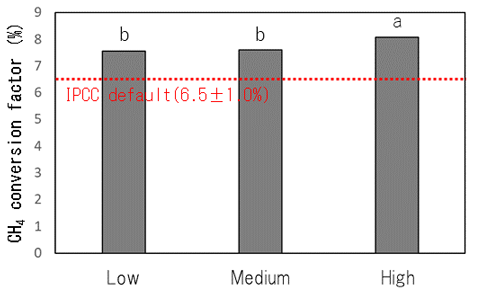Prediction of enteric methane emission from beef cattle in Southeast Asia
Description
Improving national greenhouse gas (GHG) inventories is important in projecting GHG emission trends and constructing mitigation strategies. The significant contributions of enteric methane (CH4) emissions to global GHG emissions indicate the necessity for improving CH4 emission estimates. Enteric CH4 from ruminants is produced during fermentation of dietary carbohydrates in the rumen, and consequently, enteric CH4 emission is principally affected by feed intake and the type and digestibility of feed. Therefore, various equations based on dietary intake and its components for estimating enteric CH4 emission have been provided for animal species, production systems, and regions. However, little information is available in Southeast Asia, a region characterized by producing large numbers of beef cattle in monsoonal agricultural systems focused on rice production. To develop equations for estimating enteric CH4 emissions from beef cattle in Southeast Asia using commonly available indices, we carried out meta-data analysis using data obtained in Thailand and Vietnam.
During the period 2005–2015, individual data (n = 332) were collected from 25 studies carried out in Thailand and Vietnam using a ventilated respiration apparatus equipped with a head hood. The dataset included observations on feed chemical composition, nutrient intakes, digestibilities, and CH4 emissions. The animals from which data were obtained were Brahman male cattle (n = 171), Thai native male cattle (n = 121), and Lai Sind male cattle (n = 40; Photo 1).
The best equation to predict daily CH4 emissions included dry matter intake and ether extract contents (Equation 1 in Table 1). The equation including only dry matter intake as a variable was also good for prediction (Equation 2). The best equation to predict methane conversion factor, expressed as CH4 energy as a portion of gross energy intake, was obtained using DMI per body weight, content of ether extract and crude protein, and DM digestibility (Equation 3). Mean methane conversion factor (MCF) of cattle in High roughage group (≥0.68 kg/kg in their feed as DM) was higher than that of cattle in Medium (0.34–0.67 kg/kg) and Low (≤0.33 kg/kg) roughage groups (8.1%, 7.3% and 7.3%, respectively; Figure 1). Those MCFs were higher than default MCF by the Intergovernmental Panel on Climate Change (IPCC; 6.5 ± 1.0%) for cattle, excluding fattening cattle fed diets containing 90% or more concentrates. These higher MCFs were considered to reflect the characteristics of cattle feed containing relatively higher fiber contents in Southeast Asia. These present equations are applicable to improving CH4 emission estimation in Southeast Asia.
Figure, table
-
Photo 1. Cattle breeds used in measuring methane emissions
-
Table 1. Regression equations for predicting daily methane emission and methane energy as a proportion of gross energy intake in cattle
RMSER2(1)CH4 = 22.67×DMI - 3.73×EE + 23.3218.640.783(2)CH4 = 22.71×DMI + 8.9119.360.766(3)MCF = -0.782×DMIBW - 0.436×EE-0.073×CP + 0.049×DMD + 8.6541.3480.391CH4, daily methane emission (g/day); MCF, methane conversion factor expressed as methane
energy as a portion of gross energy intake (J/100 J); DMI, dry matter (DM) intake (kg/day); EE, ether extract content (% DM); CP, crude protein content (% DM); NDF, content of neutral detergent fiber (% DM); DMD, DM digestibility (%); DMIBW, DMI per BW (kg/100 kg); RMSE, root mean square error. -
Fig. 1. Methane conversion factors in cattle by roughage proportion groups. Cattle were separated by roughage proportion (DM basis) into Low roughage (≤0.33 kg/kg), Medium roughage (0.34–0.67 kg/kg), and High roughage (≥0.68 kg/kg) groups. Dashed line shows default methane conversion factor for cattle excluding feedlot fed cattle. abP<0.05
- Affiliation
-
Japan International Research Center for Agricultural Sciences Crop, Livestock and Environment Division
- Research project
- Program name
- Term of research
-
FY2018 (FY2014-FY2018)
- Responsible researcher
-
Suzuki Tomoyuki ( Institute of Livestock and Grassland Science, NARO )
ORCID ID0000-0002-5313-7647KAKEN Researcher No.: 70391175Sommart Kritapon ( Khon Kaen University )
ORCID ID0000-0002-6947-412XArun Phromloungsri ( Khon Kaen University )
Angthong Wanna ( Department of Livestock Development, Ruminants Feeding Standard Research and Development Center, Thailand )
Nguyen Van Thu ( Can Tho University )
Chaokaur Annan ( Silpakorn University )
Nitipot Peerapot ( Kalasin University )
Cai Yumin ( Institute of Livestock and Grassland Science, NARO )
ORCID ID0000-0003-2650-5210KAKEN Researcher No.: 80355114Nishida Takehiro ( Obihiro University of Agriculture and Veterinary Medicine )
ORCID ID0000-0002-0146-9279KAKEN Researcher No.: 70343986Terada Fuminori ( Tohoku University )
KAKEN Researcher No.: 50355111Sakai Takashi ( University of Miyazaki )
Kawashima Tomoyuki ( University of Miyazaki )
ORCID ID0000-0002-6132-9470KAKEN Researcher No.: 10355068 - ほか
- Publication, etc.
-
https://doi.org/10.1111/asj.13058
Suzuki T et al. (2018) Animal Science Journal, 89:1287-1295
- Japanese PDF
-
A4308.41 KB
A3247.34 KB
- English PDF
-
A4203.8 KB
A3261.47 KB
- Poster PDF
-
2018_A01_poster.pdf345.89 KB


